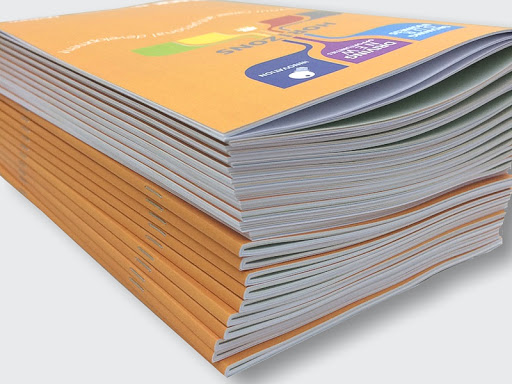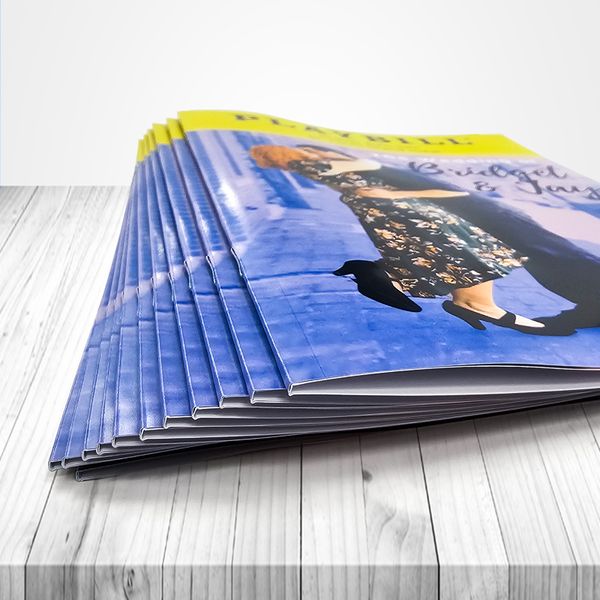Enhancing Trade Show Success with Strategic Booklet Printing
The Vital Guide to Understanding Booklet Printing Options and Techniques
The process of pamphlet printing entails several considerations that can greatly impact the last item. From selecting the appropriate layout and size to understanding the subtleties of binding approaches, each option plays an essential duty. In addition, elements such as paper stock and printing strategies more affect the effectiveness of the pamphlet. As one navigates these options, it ends up being imperative to realize how they interconnect and what that implies for the general end result.
Understanding Brochure Layouts and Dimensions
When taking into consideration booklet printing, recognizing the various layouts and sizes readily available is vital for attaining the preferred discussion. Booklets can be created in numerous styles, consisting of saddle-stitched, spiral-bound, and perfect-bound, each offering unique advantages. Usual sizes range from standard letter (8.5 x 11 inches) to smaller options like A5 (5.8 x 8.3 inches), enabling flexibility based upon web content and target audience.Selecting the suitable size can affect both the format and reader interaction. Bigger sizes could suit visually driven web content, while smaller sized formats might be much more easy to use and mobile. Additionally, the number of web pages influences the choice of binding method, as thicker brochures might require stronger bindings. Eventually, recognizing these facets permits a much more customized strategy, guaranteeing that the end product straightens with the intended message and aesthetic, enhancing the overall efficiency of the communication.
Picking the Right Paper Stock

Binding Methods: Factors To Consider and choices
When it pertains to binding approaches for brochures, several options are available, each with distinctive benefits. Saddle stitch binding uses an economical service for thinner pamphlets, while best binding techniques offer a more refined seek thicker publications. Wire-O binding stands apart for its toughness and convenience of usage, making it excellent for documents that need versatility.
Saddle Stitch Binding
Saddle stitch binding uses a cost-efficient and practical service for putting together brochures, making it a popular choice among organizations and publishers. This binding approach entails folding sheets of paper in fifty percent and stapling them along the fold line, creating a neat and organized appearance. Typically suitable for pamphlets with a lower page count, saddle sewing is excellent for publications, pamphlets, and instructional materials. The simplicity of this method allows for quick manufacturing and is usually preferred for advertising products or short runs. It is crucial to keep in mind that saddle stitch binding may not be ideal for thicker brochures, as the spinal column might not hold up under enhanced weight. Overall, it continues to be a reputable option for lots of printing tasks.
Perfect Binding Techniques
Perfect binding is a widely utilized method that supplies a polished and professional finish to pamphlets and magazines. This method entails gluing the pages together at the back using a solid adhesive, permitting a tidy side and the capability to hold a larger number of web pages compared to saddle stitching. Perfect binding is specifically suitable for thicker brochures, such as catalogs and annual records, where a sturdy, flat back is preferred. Additionally, it provides the alternative for a published cover that can be developed to boost aesthetic allure. However, factors to consider such as web page count, paper weight, and the meant use the pamphlet ought to be taken into consideration, as they can influence longevity and general high quality.
Wire-O Binding Options
Wire-O binding, understood for its toughness and adaptability, offers an outstanding alternative for booklets that require easy page turning and a professional look. This binding approach uses a collection of steel loopholes that hold web pages firmly, permitting them to exist level when open. It is specifically ideal for discussions, manuals, and catalogs because of its robust nature. Wire-O binding is readily available in numerous shades and sizes, fitting different page matters and thicknesses. Furthermore, it allows the incorporation of tabs and covers, improving the booklet's overall aesthetic. Considerations for Wire-O binding consist of the option of wire shade, the dimension of the loops, and the level of modification preferred, all of which can greatly influence the end product's look and functionality.
Digital vs. Offset Printing: Which Is Best for You?
When picking a printing technique for pamphlets, comprehending the differences in between digital and counter printing is necessary. Digital printing uses modern innovation to produce high-quality prints swiftly and affordably, making it suitable for short runs or tasks requiring fast turnaround times. It permits for modification, supplying the ability to publish on-demand with very little waste.In contrast, balance out printing is a standard approach that masters creating big amounts with consistent top quality. It includes moving ink from a plate to a rubber blanket, after that to the paper, which results in lively colors and exact details. However, balance out printing commonly calls for longer configuration times and is extra affordable for bigger volumes.Ultimately, the selection between digital and balance out printing my sources relies on project demands, budget plan, and wanted amount. For little, time-sensitive tasks, electronic could be the very best selection, while balanced out may be more effective for bigger, high-quality productions.

Designing Your Booklet: Tips and Ideal Practices
When making a pamphlet, careful attention to layout, typeface option, and color use can considerably boost its efficiency. A well-structured layout overviews the viewers's eye, while suitable font styles assure readability and share the wanted tone. Furthermore, reliable use color can stimulate emotions and emphasize essential information, making the total style more impactful.
Picking the Right Design
Just how can one properly select the right format for a booklet? It is necessary to assess the pamphlet's objective and target audience. A tidy, arranged format boosts readability and involvement. Making use of a grid system can aid in aligning elements consistently, creating an expert look. Additionally, including visual power structure through differing dimensions and positionings of photos and message can direct the viewers's eye and emphasize crucial info. It is additionally vital to leave adequate white room, which stops congestion and permits much better emphasis. Finally, examining different formats via mock-ups can offer understanding right into exactly how the layout performs in real-world scenarios, making sure that the end product fulfills both aesthetic and practical needs.
Selecting Suitable Font Styles
An appropriate font style can considerably boost the overall style of a brochure, matching the design and strengthening the material's message. The choice of typefaces should think about readability, particularly for body text, as it ensures the details is easily accessible to all viewers. Sans-serif font styles are usually chosen for electronic styles, while serif typefaces can lend a standard feeling in published products. It's a good idea to restrict font options to two or three to keep aesthetic coherence. In addition, font dimension plays a crucial function; headings ought to be not frustrating however distinct, while body message must fit for reading. When selecting typefaces, positioning with the booklet's theme and target market is vital for efficient communication and visual charm.
Effective Use Color
Shade Get the facts serves as an effective tool in brochure design, shaping understandings and guiding visitor emotions. It can stimulate sensations of peace, excitement, or count on, relying on the tones selected. Designers need to consider color concept concepts, ensuring that the selected combination straightens with the booklet's message and target audience. Using cozy colors like red and orange can produce necessity, while cooler tones like eco-friendly and blue foster tranquility.Additionally, contrast plays an important function; complementary shades can enhance readability and visual charm. Consistency in color usage across web pages even more enhances brand identity and cohesion. Ultimately, effective color implementation not only records focus yet additionally enhances the booklet's purpose, making it a vital element of successful design.
Finishing Touches: Coatings and Special Results
While numerous think about the material and layout of a booklet one of the most essential components, the ending up touches, such as finishes and unique impacts, play an important role in improving its total allure. Coatings can offer protection and resilience, ensuring that the pamphlet holds up against damage. Matte surfaces offer an innovative, non-reflective surface area, while glossy coatings can make colors appear even more eye-catching and vivid. Special impacts, like embossing or foil marking, add a responsive dimension that can develop an unforgettable impression. These strategies can highlight certain areas, accentuating vital information or producing visual rate of interest. Additionally, UV finish can offer a high-shine coating that elevates the total look.Together, these completing touches not only boost the brochure's aesthetic but also connect professionalism and reliability and focus to information, eventually leaving a long lasting influence on the visitor.
Cost Factors To Consider for Pamphlet Printing
Comprehending the numerous cost factors to consider for brochure printing is important for organizations and services intending to maximize their budgets. Trick factors influencing expenses consist of the selection of binding, paper, and ink techniques. Better materials, such as exceptional paper or specialized inks, normally enhance the overall expense. Furthermore, the size and page matter of the brochure play a substantial role; bigger pamphlets call for even more sources and time to produce.Another important consideration is the printing technique, Get More Information whether electronic or countered, as each has its very own rates framework and viability for various quantities. Organizations must additionally consider style expenses, which can differ based on complexity and the use of expert services. Ultimately, shipping and handling fees can contribute to the total, specifically for big orders. By assessing these aspects, organizations can make enlightened decisions that align with their economic capabilities while achieving the wanted top quality in their published materials.
Frequently Asked Questions
What Are the Ecological Effects of Booklet Printing?
The environmental influences of brochure printing include deforestation from paper production, carbon emissions from transport, and waste generation from thrown out materials - Booklet Printing. Sustainable methods, such as making use of recycled paper and environment-friendly inks, can mitigate these effects
How Can I Guarantee Color Accuracy in My Booklet?
To guarantee color accuracy in a brochure, one ought to make use of adjusted monitors, utilize specialist color profiles, perform test prints, and select high-quality printing solutions that use color matching and proofing alternatives for finest outcomes.
What Is the Common Turn-around Time for Pamphlet Printing?
The normal turn-around time for brochure printing differs depending upon the complexity and quantity - Booklet Printing. Usually, it varies from a couple of days to two weeks, affected by elements such as publishing methods and ending up demands
Exist Minimum Order Quantities for Brochure Printing?

Can I Print Brochures in Several Languages?
Publishing booklets in several languages is feasible. Several printing solutions offer options for multilingual or multilingual designs, enabling effective interaction. Mindful preparation warranties that design elements suit various languages without compromising readability or appearances. Furthermore, variables such as paper stock and printing methods further influence the effectiveness of the booklet. When considering pamphlet printing, comprehending the various formats and sizes readily available is necessary for attaining the desired presentation. When choosing a printing approach for booklets, understanding the differences in between digital and counter printing is crucial. Furthermore, the dimension and page count of the brochure play a substantial role; bigger pamphlets require more sources and time to produce.Another important factor to consider is the printing technique, whether electronic or countered, as each has its own pricing framework and viability for various quantities. The ecological effects of pamphlet printing consist of logging from paper production, carbon discharges from transportation, and waste generation from thrown out materials.